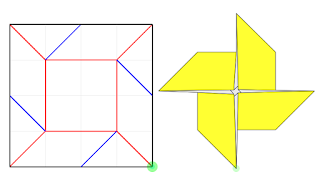The spider looks funny and rather, cute.
Downloads
Crease pattern can be downloaded here.
Design
I wasn't worried about the legs since they should be straightforward. So I started with the abdomen.
The abdomen needs to be color-changed, and then color-changed once more to draw the pattern. I was inspired to use windmill base, since some people in Origami-dan like to use it for designing 2D color-changed models. Windmill base is versatile because it has 4 flaps which fully cover perimeter of paper, and as we know color-change is normally done on perimeter.
 |
| Windmill base. See the grey part on folded model shows the paper perimeter. |
Now I just need to make similar flaps that is from paper perimeter. This is easily done on box pleating with array of 1 unit flaps:
 |
| Five 1-unit flaps that is usable for color change. |
Finally to make the pattern, I strip grafted the flaps to add extra perimeter. It is shown on the CP.
To get the top strip, do a reverse fold and slightly lift up the corner.
For the "circle" and dot, start from reverse-folded shape like before, then improvise.
Just be sure to fold it accurately! The one in picture is very sloppy and just for demonstration purpose.
For the eyes, there's a way to make seamless rhombuses.
The main challenge of this model is accurate and symmetric fold. My dexterity and fine control is still low, so the result isn't as good as I imagined. Some time in the future I'll refold it after I grind with more models.




Comments
Post a Comment